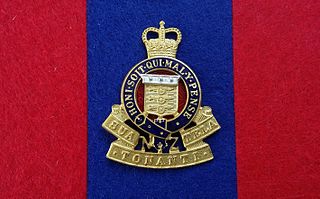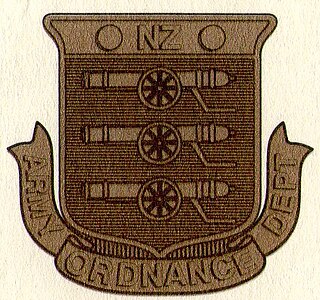
Quartermaster is a military term, the meaning of which depends on the country and service. In land armies, a quartermaster is generally a relatively senior soldier who supervises stores or barracks and distributes supplies and provisions. In many navies, a quartermaster is an officer with particular responsibility for steering and signals. The seaman is a non-commissioned officer rank; in some others, it is not a rank but a role related to navigation.
Historically, an armourer is a person who makes personal armour, especially plate armour.

The Royal New Zealand Army Logistic Regiment (The Duke of York's Own), is the New Zealand Army's main military Logistics and combat service support (CSS) element. It is the largest regiment in the NZ Army.

The United States Army Quartermaster Corps, formerly the Quartermaster Department, is a sustainment and former combat service support (CSS) branch of the United States Army. It is also one of three U.S. Army logistics branches, the others being the Transportation Corps and the Ordnance Corps.

The Corps of Royal Canadian Electrical and Mechanical Engineers (RCEME) is a personnel branch of the Canadian Armed Forces (CF) that provides army engineering maintenance support. All members of the corps wear army uniform. From the 1980s to 2013 it was called the Electrical and Mechanical Engineering Branch.
An ammunition technician (AT) is a British Army soldier, formerly of the Royal Army Ordnance Corps but since 1993 of the Royal Logistic Corps, trained to inspect, repair, test, store, and modify all ammunition, guided missiles, and explosives used by the British Army. These technicians are also trained to use demolition to safely dispose of individual items of ammunition and explosives (EODs) or to conduct logistics disposal of bulk stocks of multi items. After gaining sufficient experience, those who show the appropriate qualities are given extra training to render safe improvised explosive devices (IEDs) by a process called improvised explosive device disposal. Experienced ATs may be called to give evidence as expert witnesses in criminal or coroner's courts in relation to ammunition or explosives or to EOD and IEDD duties.

The Royal Australian Army Ordnance Corps (RAAOC) is the Corps within the Australian Army concerned with supply and administration, as well as the demolition and disposal of explosives and salvage of battle-damaged equipment. The Corps contains clerks, operator supplies, petroleum operators, parachute riggers and ammunition technicians. Members of the Corps are nicknamed Roaches.
The Royal Signals trades are the employment specialisations of the Royal Corps of Signals in the British Army. Every soldier in the Corps is trained both as a field soldier and a tradesman. There are currently six different trades, all of which is open to both men and women:

The ANZUK Ordnance Depot was established in 1971 to provide logistical support to Australian, New Zealand and British forces stationed in Singapore and Malaysia as part of ANZUK Force. It was commanded by a Royal Army Ordnance Corps officer of the rank of lieutenant colonel and staffed by Australian, New Zealand and United Kingdom personnel and Locally Employed Civilians. This organisation operated for only a short period. Australia changed Government in 1972 and the incoming Labor Government decided to withdraw Australia’s commitment to the region. This took effect in 1974 and was followed later by the withdrawal of the British forces. It was then decided that New Zealand should form its own Advanced Ordnance Depot, designated the New Zealand Advanced Ordnance Depot (NZAOD). This was the start of a commitment which was to last until December 1989.

The Royal New Zealand Electrical and Mechanical Engineers (RNZEME) was a New Zealand Army Corps comprising Army trained tradesmen (craftsmen) who repaired Army equipment wherever New Zealand Forces served.

The Royal New Zealand Army Ordnance Corps (RNZAOC) concerned itself with the provisioning of troops with the means to fight; specifically uniforms, weapons and equipment. Ordnance functions go back hundreds of years; the first Ordnance Officer in the British military appeared in the year 1299. Designated "Keeper of the King's Wardrobe", his duties included the care and accounting of heavy equipment such as battering rams and catapults.
Authority was granted under New Zealand Defence Forces General Order 90 to raise the New Zealand Army Ordnance Section with effect from 1 April 1915.

New Zealand Force South East Asia (NZFORSEA) (1974–1989) comprised the elements of the Royal New Zealand Navy, New Zealand Army and Royal New Zealand Air Force. Much of the New Zealand military left Singapore as part of operation Kupe in 1989, leaving behind a residual Defence Support Unit (NZDSU).
The Defence Stores Department was a department of the New Zealand Defence Department responsible for the purchase, receipt, issue and repair of stores, initially for the Armed Constabulary and then the Permanent and Volunteer Forces of New Zealand from 1862 to 1917.
From four Stores Depots in the main centres of New Zealand at the beginning of the 20th century, the Royal New Zealand Army Ordnance Corps (RNZAOC) expanded and shrank to meet the operational needs of the NZ Army, Ordnance units have been deployed worldwide and across the breath and width of New Zealand.
Thomas James McCristell (1873–1946) was a professional soldier of the British and New Zealand Army, who served in India, South Africa who progressed through the ranks to become the Head of the New Zealand Army Ordnance Corps and New Zealand Army Ordnance Department on their formation in 1917.

The New Zealand Army Ordnance Department (NZAOD) was the organisation of commissioned officers who were responsible for the supply, maintenance and repair of equipment, small arms and all stores required for the Defence Force from 1917 to 1923.
The New Zealand Army Ordnance Corps (NZAOC) was a Corps whose function was to provide, receive, store, repair, maintain, and issue: ordnance stores, vehicles, ammunition, foodstuffs, and ammunition. Ordnance Organisations had previously existed in the Royal New Zealand Artillery and the New Zealand Defence Stores Department, who for the Territorial Army established a temporary Ordnance Deport organisation and trained staff in Ordnance functions for the 1913 and 1914 Annual camps, so that on the eve of the great war a cadre existed within the Territorial Army to establish an Ordnance Corps to support the NZEF.
84 Medical Supply Squadron is a squadron of the British Army's Royal Logistic Corps. It is currently attached to 9 Regiment RLC and provides medical supply to the British Armed Forces when deployed on operations around the world.